A SHORT HISTORY OF THE LOUXOR
The Louxor today
The Louxor is one of the few historic cinemas remaining in Paris and the only theatre in France to be decorated in the Egyptian style. In 1981 it was listed as Historic Heritage.
Now belonging to the City of Paris, it is operated by CineLouxor, a team of three managers with a long experience in cinema production, distribution and management.
The Louxor offers art cinema (with a prominent place for films from other cultures) and special programmes for schools and young children. Tickets are priced to facilitate access to a wide public. It also hosts frequent premieres and invites actors and film makers to meet the audience.
On the 3d floor, a bar opening onto a terrace offers an amazing view onto the Sacré Cœur.
Since its reopening in April 2013 the Louxor has been an enormous success.
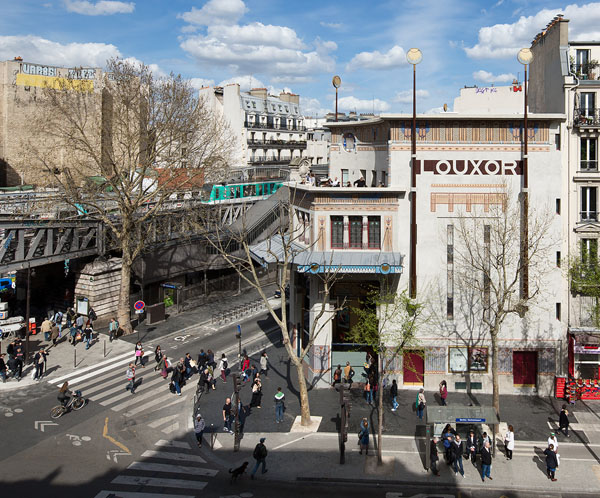
Photo Luc Boegly © éditions A.A.M
Saving the Louxor
After the cinema closed its doors on 30 November 1983, the building was sold by the Pathé group to a clothing chain store. Between 1986 and 1988, it was turned into a West Indian nightclub, La Dérobade, soon replaced by a gay disco, Megatown, which closed down one year later.
The Louxor then remained vacant. In spite of its listed status, it was left by its new owner in a shocking state of dereliction. In 2000, local associations, as well as cinema and architecture lovers decided to take action. Supported by a number of cultural figures (actors, film makers, journalists), they set up a “Save the Louxor” committee, wrote letters to the newly elected mayor of Paris, Bertrand Delanoë, and to the local politicians, staged a demonstration in front of the Louxor and started a petition asking the Mayor to purchase the building and return it to its original status as a cultural institution.
In July 2003 the City bought the Louxor. Five more years elapsed before an ambitious renovation project was presented to the public in 2008 by architect Philippe Pumain.
Renovating the Louxor
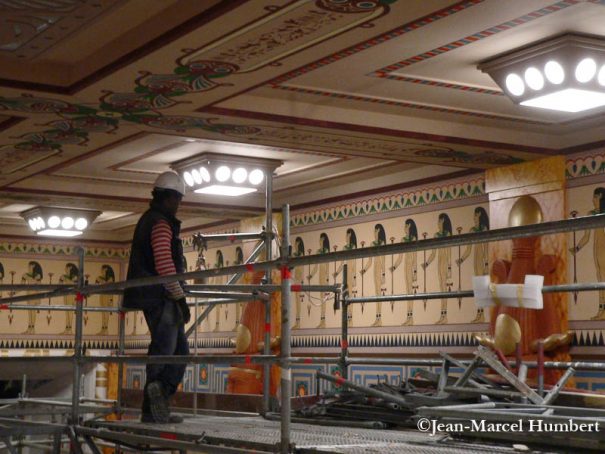
The main auditorium, 8 November 2012
The challenge for the architect was to reconcile heritage and modernity. The main (originally 1395, now 342-seat) auditorium has retained its two balconies. The original Egyptian decoration has been reproduced on the walls of “the box within the box” designed to ensure that the three auditoriums are completely insulated from each other, from the street and metro, and from the adjoining buildings. The 1921 screen with its ornate frame has been beautifully reproduced. Usually hidden by the modern large screen, it is used for silent film screening.
As the standards require, the cinema is accessible to disabled people.
The Art Deco granito façade has been restored by Heritage architect Christian Laporte. The mosaics, the painted frieze and stucco decorations of the entrance porch, as well as other characteristic features of the Louxor such as the ironwork and stained glass windows – even the Egyptian poles which decorated the façades in 1921 – have been expertly restored or reproduced.
Two smaller auditoriums, soberly decorated with a touch of Egyptian style, have been added in the basement to offer a wider variety of programmes, ensuring greater profitability.
After four years’ renovation at a total cost of 24 million euros, the Louxor re-opened on 17 April 2013. It is the only surviving cinema in the Barbès neighbourhood.
An Egyptian palace
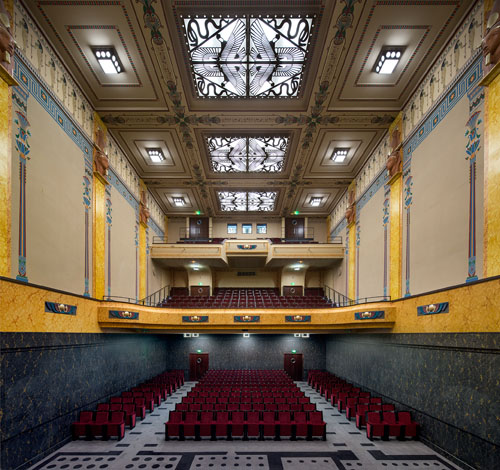
The main auditorium. Photo Luc Boegly© éditions A.A.M
Some characteristic symbols of Egyptian art are featured both inside the Louxor and on its façades:
– winged sun discs (in mosaics, metalwork, or plaster)
– the uraeus (the rearing cobra symbol) is seen on either side of the winged discs and on the Pharoahs’headdresses on top of the pillars in the main auditorium.
– friezes of winged scarabs (along the cornices)
– lotus flowers (in mosaics on the façade and, together with papyrus reeds, on the painted columns of the main auditorium)
– on either side of the auditorium, and above the screen, a painted frieze displays a procession of young women carrying the Ouadj sceptre (symbolizing youth) and the ankh, a symbol of rebirth and eternity.
– Nekhbet, the vulture goddess is featured on the overhead lights of the main auditorium and in the upper corners of the 1921 screen.
A short history of the building
The 1395-seat Louxor Theatre was specifically designed for the cinema by architect Henry Zipcy for a business man, Henry Silberberg. Built in 1921 on the location of a former Haussmann-style building, the Louxor was one of the most luxurious theatres in Paris. The interior decoration, painted by Amédée Tiberti, and the colourful mosaics of the façade by the Gentil and Bourdet factory were in the Egyptian style. The auditorium was equipped with an organ built by John Abbey. The Louxor opened its doors on 6 October 1921.
But Henry Silberberg went bankrupt and died on 23 November 1921. The Louxor was sold in April 1922 to the Lutetia-Fournier circuit which already controlled about a dozen cinemas.
In 1929, the cinema was bought by the Pathé group which installed a sound system for “talkies” and replaced the Egyptian interior decoration by “neo-Greek” patterns while retaining some Egyptian features like the winged discs of the balconies.
In 1954, the Louxor was completely renovated by Pathé and the neo Greek designs of the auditorium were hidden under a new decoration.
In the 1960s, huge murals depicting film stars or film characters (like John Wayne or Batman) were installed on the façades.
Although the Louxor was briefly converted into discotheques after the cinema closed down, it fortunately underwent no severe restructuring.
The programmes, 1921-1983
The 1920s were the Golden Age of silent cinema. The standard three-hour-long programme – accompanied by the Louxor orchestra and organ – changed weekly. It included newsreels, short films (comic scenes, documentaries, series episodes), two feature films but also live entertainment (singers, musicians, circus performers, animal acts, etc.).
In the 1930s, the programmes usually offered a documentary, newsreels, and two long feature films.
During the German Occupation, the Louxor operated under close surveillance. On 9 September 1940, the Vichy regime banned all Anglo-Saxon films, then in May 1941, all films – whatever their nationality – released before 1 October 1937. Only unrestricted access to German films was allowed. The programmes included only one feature film preceded by a documentary and propaganda newsreels (projected in a dimly-lit auditorium to discourage hostile reactions). From 1942 to 1944, the production of French films was resumed, bringing back onto the screen the well-known actors loved by French audiences.
After the war, the Louxor offered mainstream programmes likely to attract a popular audience: comedies, thrillers, cloak and dagger films, big budget American productions. Attendance reached record numbers (727 030 spectators in 1946). But at the end of the 1950s, admissions started to drop and reached an all-time low in 1965 with 165 000 spectators.
1968 – 1983: new programs for new spectators
The manager of the Louxor tried to attract the immigrant workers now living in the Barbès neighbourhood by slashing ticket prices from 6,30 francs to 2 francs. He also changed the programmes and chose to show Epic swords and sandals movies, spaghetti westerns, war, kung fu or adventure films.
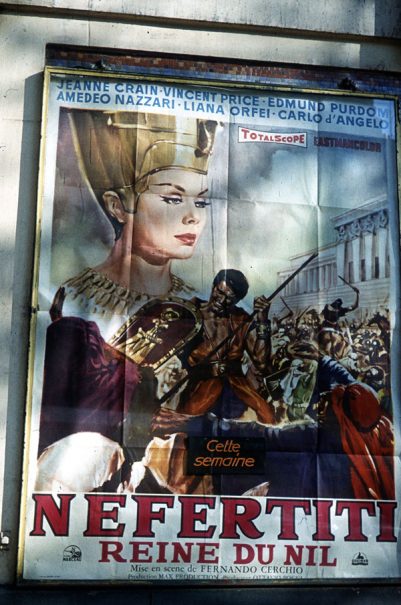
Nefertiti (Louxor : 10-16 November 1971)
From 1973, films about the Algerian war (like The Battle of Algiers by Gilles Pontecorvo), as well as Egyptian and other Arab films drew crowds. Attendance rates soared with an average of 9 to 10 000 tickets sold each week.
At the beginning of the 1980s the Louxor turned to Indian films (classics like Mother India or recent Bollywood productions), often subtitled in Arab and French. But attendance started to fall again at the end of the 1970s. The last picture show took place on 29 November 1983, with the Indian film Qaid.
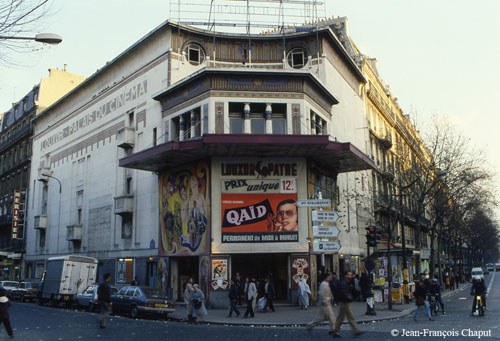
The last picture show, 29 November 1983
At last, after 30 years of closure, the Louxor has been splendidly restored and returned to its original use.
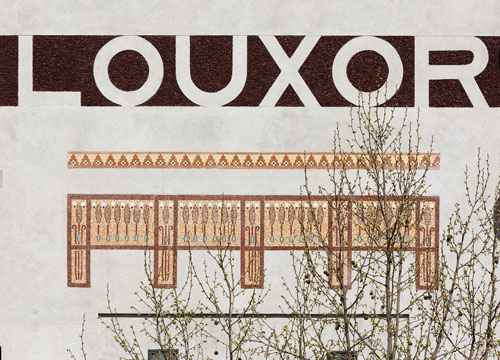
Photo Luc Boegly©éditions A.A.M
Texte anglais : Annie Musitelli, relectures : Catherine Wynne et Ken Roe
© Les Amis du Louxor
